Prior to the declassification of various formerly TOP SECRET documents there was a widely held misconception that JFK was responsible for having involved the United States in the Vietnam war—not responsible so much for beginning the war, but responsible for having escalated it.
One document that clearly refutes such a claim, NSAM 263, appears on the left.
However, there is considerable “built in” mystery surrounding this document, as well. The document is itself more “cover letter”[1] than anything else because it does not delineate the contents of the reference contained therein, namely, the McNamara-Taylor Report (Section I B [1-3])*.
That section of the McNamara-Taylor Report, to which NSAM 263 refers and therefore incorporates by reference, [particularly items 2 and 3] goes to the heart JFK’s policy to withdraw from Vietnam and is crucial to appreciating its significance.
Note that there is nothing ambiguous in the wording: JFK was withdrawing from Vietnam by adopting a policy and implementing a strategy to transfer the US military’s mission in Vietnam to the Government of South Vietnam by the end of 1965.
NSAM 263
[1] Telephonic conversation between author and the late Colonel L Fletcher Prouty, USAF
NATIONAL SECURITY ACTION MEMORANDUM NO. 263
TO:
Secretary of State
Secretary of Defense
Chairman of the Joint Chiefs of Staff
SUBJECT: South Vietnam
At a meeting on October 5, 1963, the President considered the recommendations contained in the report of Secretary McNamara and General Taylor on their mission to South Vietnam.
The President approved the military recommendations contained in Section I B (1-3)* of the report, but directed that no formal announcement be made of the implementation of plans to withdraw 1,000 U.S. military personnel by the end of 1963.
After discussion of the remaining recommendations of the report, the President approved the instruction to Ambassador Lodge which is set forth in State Department telegram No. 534 to Saigon.
McGeorge Bundy
Copy furnished:
Director of Central Intelligence
Administrator, Agency for International Development
cc: Mr. Bundy
Mr. Forrestal
Mr. Johnson
NSC Files
[SECTION] 1: CONCLUSIONS AND RECOMMENDATIONS
B. Recommendations.
We recommend that:
1. General Harkins review with Diem the military changes necessary to complete the military campaign in the Northern and Central areas (I, II, and III Corps) by the end of 1964, and in the Delta (IV Corps) by the end of 1965. This review would consider the need for such changes as:
a. A further shift of military emphasis and strength to the Delta (IV Corps).
b. An increase in the military tempo in all corps areas, so that all combat troops are in the field an average of 20 days out of 30 and static missions are ended.
c. Emphasis on “clear and hold operations” instead of terrain sweeps which have little permanent value.
d. The expansion of personnel in combat units to full authorized strength.
e. The training and arming of hamlet militia to an accelerated rate, especially in the Delta.
f. A consolidation of the strategic hamlet program, especially in the Delta, and action to insure that future strategic hamlets are not built until they can be protected, and until civic action programs can be introduced.
2. A program be established to train Vietnamese so that essential functions now performed by U.S. military personnel can be carried out by Vietnamese by the end of 1965. It should be possible to withdraw the bulk of U.S. personnel by that time.
3. In accordance with the program to train progressively Vietnamese to take over military functions, the Defense Department should announce in the very near future presently prepared plans to withdraw 1000 U.S. military personnel by the end of 1963. This action should be explained in low key as an initial step in a long-term program to replace U.S. personnel with trained Vietnamese without impairment of the war effort.
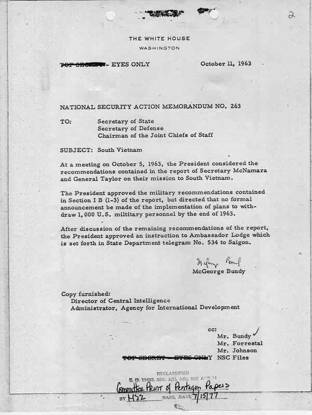
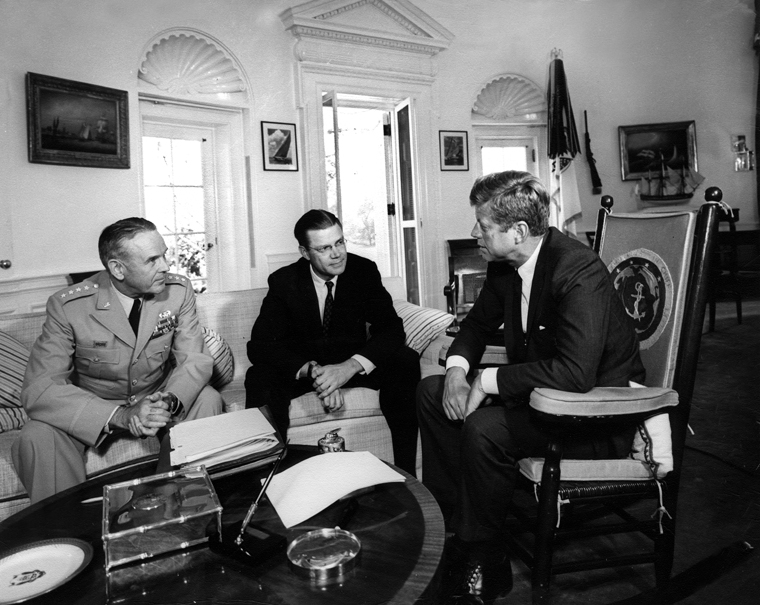
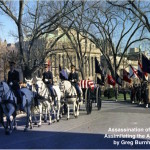
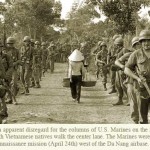

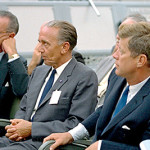

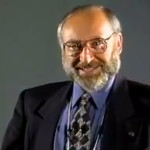
1 thought on “National Security Action Memorandum 263 – Intro”